
Tulips - The first representatives of flowers that symbolize the onset of the thaw after a long winter. So that they bloomed already in early spring, they are planted in the fall. Landing is carried out in open ground, almost before the frosts. For the process to be successful, there are several nuances. If you observe them, then nothing will happen to the bulbs, they will calmly winter, and in the spring they will rapidly grow. Florists who grow plants for years will share their experiences and secrets when and how to plant tulips in the open ground in autumn.
Content
Why plant in autumn
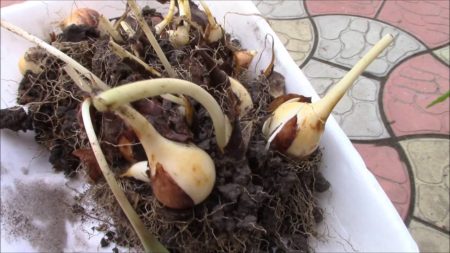
Inexperienced gardeners can make a mistake and plant a flower not in the autumn, but in the spring. The bulb can freeze quickly during such a planting, and if the plants themselves grow, their stems will be thin. Tulips bloomed in the spring bloom for a short time, literally in a couple of days the buds already wither. Planting tulips in the fall in the ground has several advantages:
- in bulbs during the winter, immune qualities increase, they do not get sick;
- flowering will be bright and last longer than usual up to several weeks;
- flowers will not be afraid of frost and cold nights.
When planting in the fall, tulip activates growth processes, the root system is rapidly forming. The roots are stocked with nutrients, which allows the bulbs to develop evenly.
When to plant tulips in autumn
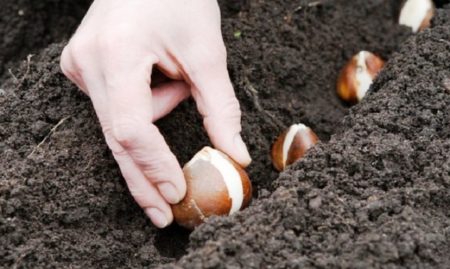
There is no clear time when to plant tulips in the winter. Each region begins its own specific period, which is due to the ambient temperature. The time for planting should be chosen just before the frost, when the temperature on the street is close to zero, but the earth has not frozen yet and maintains a temperature range of 4-8 degrees Celsius. Planting flowers too early causes the bulbs to freeze; they can rise late in the spring or even rot with the first frost.
Middle lane
For most regions of Russia, Ukraine, flowers can be planted from late September to mid-October. Choose non-rainy dry weather and get started. Be sure to pay attention to the night temperature, if it drops to + 3-5 degrees, then this is the optimal time for planting.
In the Moscow Region
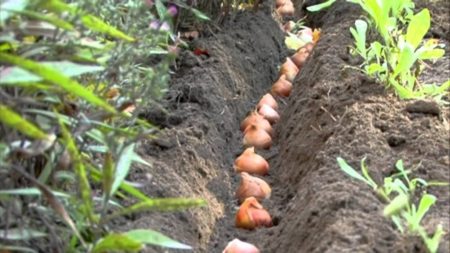
For Moscow region landing time coincides with the Middle Strip, so flowers are planted in open ground before the snow falls - in early October. If the autumn is warm, then take your time: wait for a noticeable cooling, but do not overdo it, otherwise the bulbs will zadeduyte in cold land.
For the Urals and Siberian District
For regions where winter comes much earlier than in the central part of the country, the landing period can be shifted 1-2 weeks earlier. Planting is carried out from mid-September to early October, before the appearance of snow cover. If the autumn dragged on in Siberia longer than usual, you can shift the landing a couple of days later.
How to plant tulips correctly
In addition to observing the planting period when growing plants, the planting process itself must be correctly performed. It depends on several factors: the choice of a seat, soil preparation, and onion processing. If all the conditions are fulfilled by you correctly, then tulips will appear above the ground in the earliest possible time.Proper planting and care in the open field for plants is the key to their long, abundant flowering.
Seat selection

Tulips grow well on hills, slopes and love a lot of sunlight. These main points are worth considering, so choose a place on your summer cottage that will correspond to the above factors. The lack of lighting will lead to the fact that the stems will break under the weight of the flower, and the color of the leaves with buds will not be intense enough, rather faded. Land with a low level of groundwater is categorically unsuitable, the bulbs instantly rot and die. Position the planted bed near the fence on the north side. It will protect against windy gusts of the plant, and the stems will not break and bend.
Land preparation
A couple of weeks before the autumn planting of tulips, start laying the fertile soil layer. To begin, dig the soil to a depth of at least 20 cm. Before digging, moisten the earth liberally, then digging it will be much easier. To prevent infection of the bulbs with viral and fungal diseases, treat the soil with a weak solution of potassium permanganate or a fungicidal preparation. Do not forget to process equipment together with the earth: bacteria can also be on it.
Tulips love porous soil, so add one square meter a bucket of dry river sand. To fertilize the soil with organic and mineral components, use wood ash, potassium nitrate, dolomite flour. After fertilizing, re-dig the ground and spill plenty of water.
Planting Tulip Bulbs
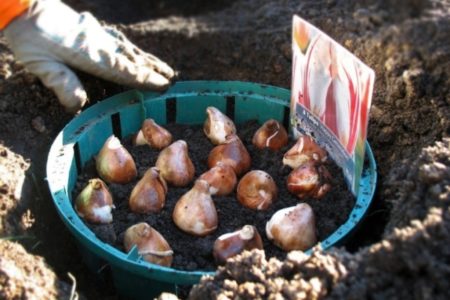
Prior to planting in the ground, carefully sort the bulbs. Those on which there are signs of rotting, damage, put aside - they will not fit for planting. Sort the remaining bulbs by size and grade. Soak the selected tubers for 20-30 minutes in a pink potassium permanganate solution or treat with a peroxide solution. Treatment with drugs will significantly reduce the risk of contracting diseases and facilitate the upcoming wintering. In no case do not soak the planting material in growth stimulants, since the root system in this case begins to develop too early, and the bulb subsequently dies.
Take prepared bulbs and place them in the ground at a distance of at least 10 cm from each other. The planting depth of plants depends on the diameter of the bulb. Ideally, the depth should be three times the diameter. No need to measure the plants with a ruler, just estimate the approximate size by eye and compare it with the depth. Do not bury the tubers more than 25 cm in the ground, otherwise the flowers will germinate for a long time. For a successful landing, use the recommendations:
- if you chose small varieties, then between them you can leave a smaller distance - about 5-6 cm;
- plant tulips in a checkerboard pattern, then you get the effect of a carpet. On average, about 100 bulbs leave to plant a square meter of land;
- Do not press on the planting material, it is easy to damage;
- place larger bulbs in the center of the ridge, otherwise they will block the lighting for small flowers;
- remember in what order you arranged the varieties, so it will be easier to look after them in the future;
- at the end of the planting, tamp the ground slightly to exclude the formation of air pits;
- level the ground, there should not be any hollows or hollows, otherwise water from the rain will accumulate there.
Experienced gardeners plant flowers not just in the ground, but in special baskets, containers or plastic boxes.The planting principle itself is not too different from the usual one, however, the bulbs in the box should be located a little farther than the usual ones from each other - somewhere at a distance of 15 cm. If your soil is heavy, with lots of clay, then it makes sense to think about growing tulip containers . Fill the containers with fertile soil, plant the onions in it, and then dig the container into a permanent place.
Further care
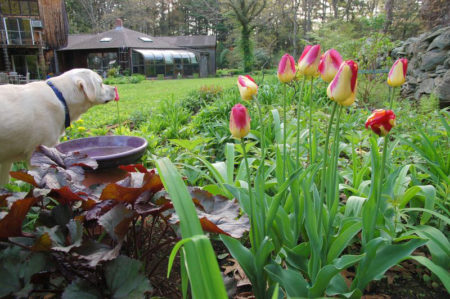
After landing, you do not need to water the land. In autumn, rains often pass, but there is no intense heat, so there will be plenty of moisture for the flowers. If autumn is dry and there is no rain for a long time, then plants need to be watered. For watering, take a watering can, fill it with cool water. You can add ammonium nitrate at the rate of 15 g of powder per square meter of ridge.
In the event of severe frosts in late autumn, mulch the soil with straw, it will retain heat inside the ground, and the bulbs will not freeze. If frost is not observed, then there is no need for mulch. Excessive warm cover, on the contrary, will lead to the early germination of tulips.
Preparation for winter

The danger to flowers is represented by rodents and mice. They can dig or damage plants in the ground, therefore it is necessary to come up with pests protection. Cover the flower bed with fir branches, you can lay a metal mesh netting on top of the beds. If you have traps from rodents, place them in a summer cottage.
When the snow falls, he will shelter the tulips from frost. Snow cover will protect the tubers from low temperature, you do not need to worry about them. In rare cases, when the winter in the region is snowless, but with large frosts, you need to cover the garden bed with agrofibre, film or any other material. With the advent of spring, shelter must be removed. The snow cover with which the bed was covered should also be scattered evenly over the site. The snowdrift will quickly begin to melt from the spring sun and excessively moisten the earth, this outcome should not be allowed. Do not completely remove snow from the bed, remove most of it, and leave the bottom layer unchanged.
Useful tips for gardeners
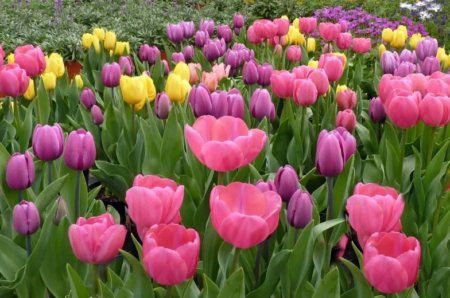
With the annual planting of tubers, you can form a flowerbed of the desired density and shape. Plants will bloom well if you follow a few simple tips:
- dig bulbs need at least 1 time in 2-3 years. When to dig up tulips different varieties are indicated in the description of the variety;
- dug bulbs must be treated with fungicidal additives, dried and only then stored;
- if you missed the landing at the end of autumn, it's okay: plant the tubers at the end of November, but only when the snow is on the ground;
- when growing varietal tulips, they must be carefully looked after. Plants need regular top dressing with a mineral composition. Varietal flowers are dug up annually immediately after flowering;
- the number of fertilizers for the entire growing season should not exceed 3-4 times. More frequent use of fertilizers causes dependence in plants and reduces the quality of planting material;
- horse, cow dung, chicken should not be used for top dressing. Tulips do not respond well to them. Under the ban fertilizers containing chlorine. They are dangerous for flowers and for the human body;
- the landing site can not be changed for several years, tulips will still be good in one place, if the soil is fertilized in it.
The timing of planting tulips in the fall, when and how to plant them is described in detail above, so take your own tips, purchase bulbs and grow your favorite spring flowers in your garden plot. Form a flowerbed at your discretion, create a bright floral arrangement that will amaze your surrounding people with its beauty.

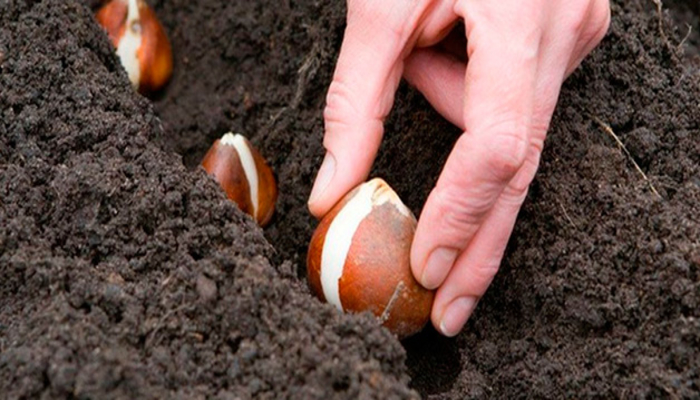
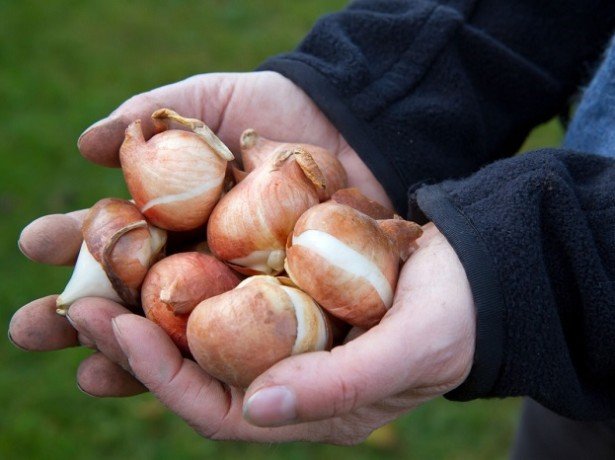
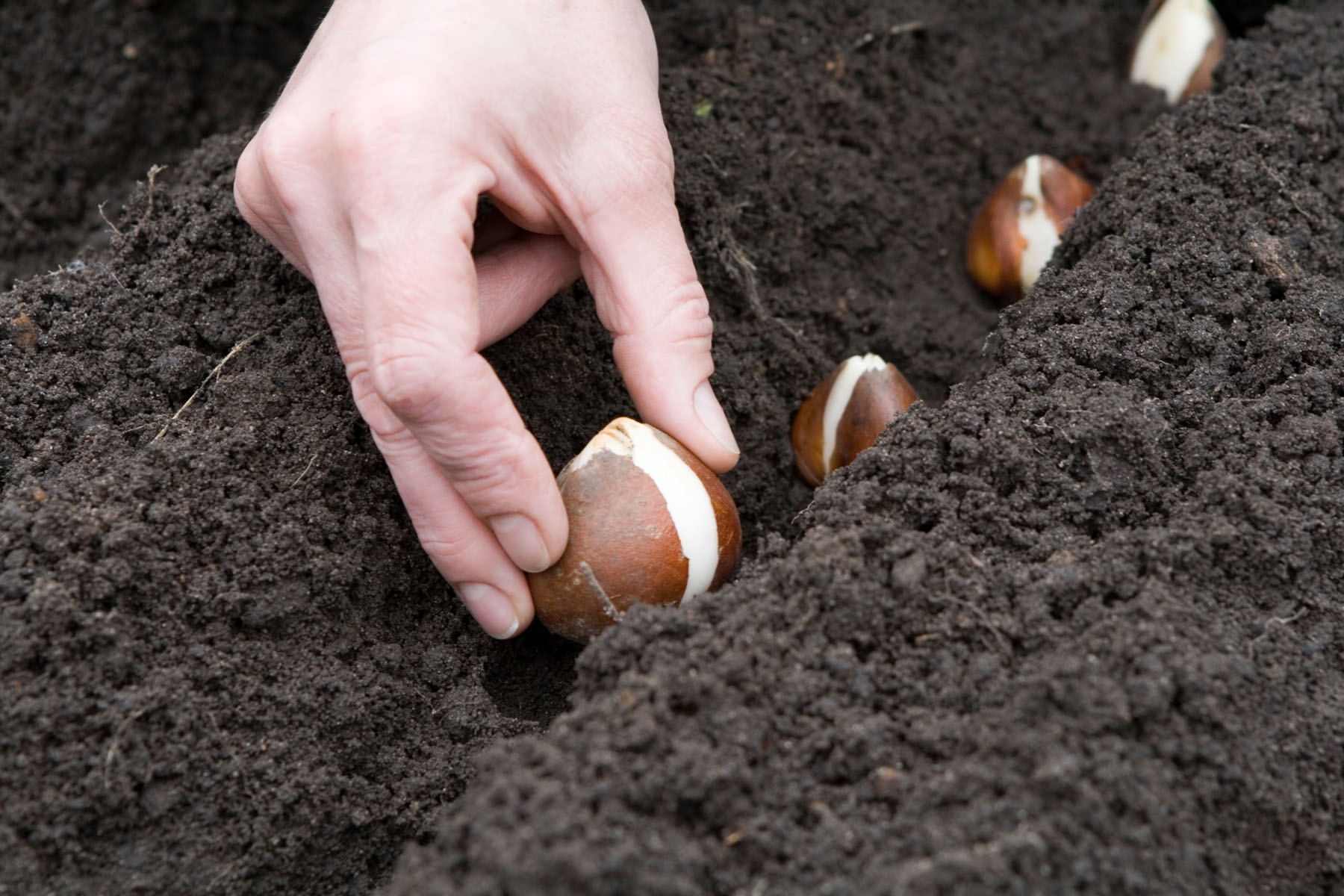
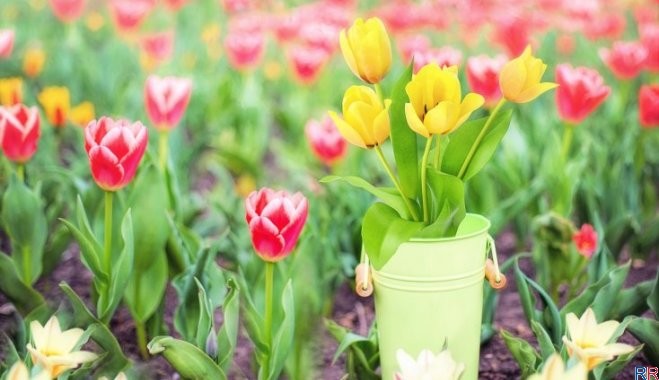 When to dig up tulips after flowering and when to plant again in the ground
When to dig up tulips after flowering and when to plant again in the ground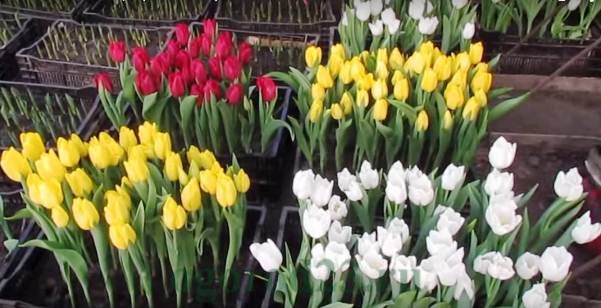 We plant tulips at home on March 8
We plant tulips at home on March 8 How to save tulip bulbs after flowering until next spring
How to save tulip bulbs after flowering until next spring